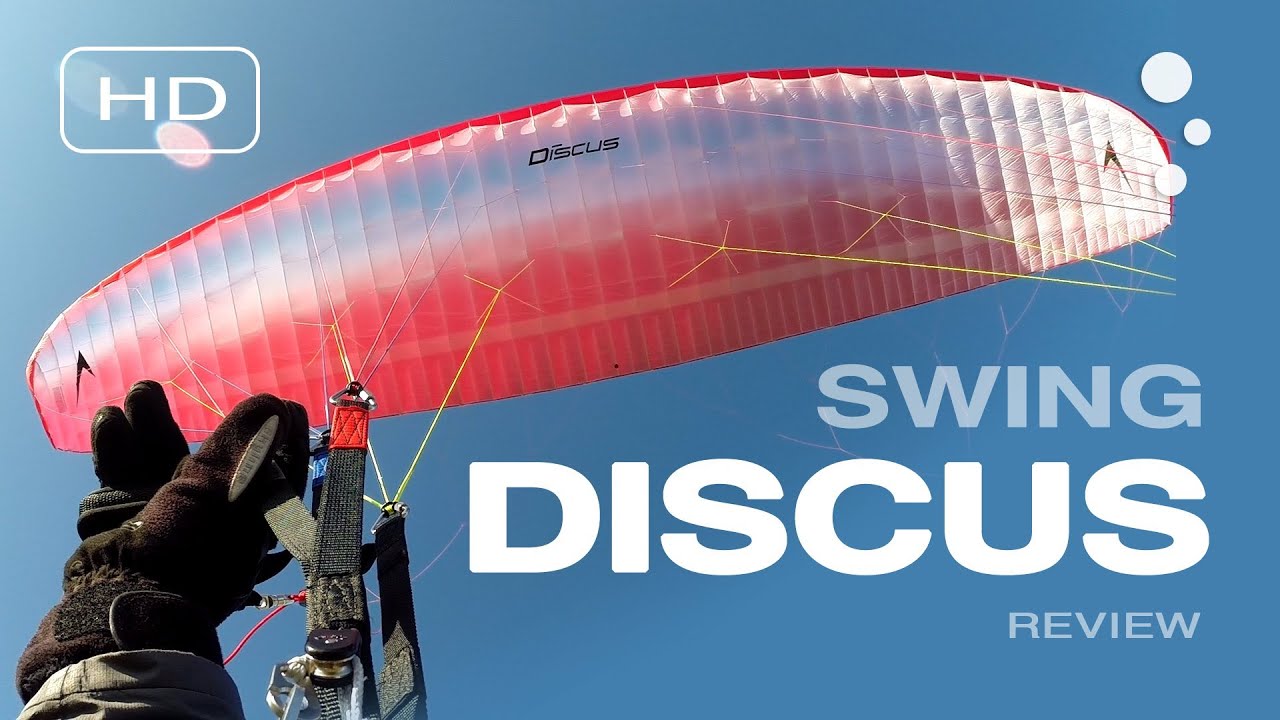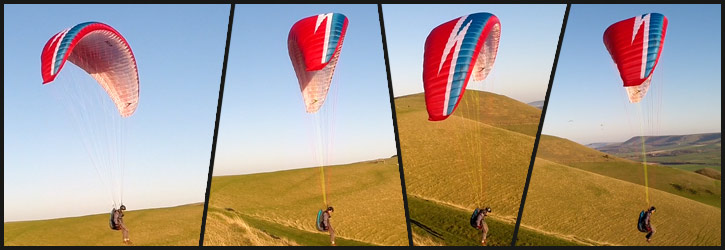
The Discus represents a new level of wing in Swing's paraglider range. Daniel Tyrkas from Swing explains: "... positioned on the upper end of EN-A... " "... between our low EN-A wing, Axis and low EN-B wing, Arcus." "The Discus is suitable not only for training but also as a first wing accompanying the pilot on their first XC flights."
Regarding what kind of pilot the Discus is aimed at, Swing say it has been "... designed for beginners, leisure and low airtime pilots, where very high passive safety is most important. Due to the EN / LTF -A certification, the DISCUS is also fully suitable for your first training flights and convinces with very easy launch, flight and landing behaviour and amazing performance for its class." "The pleasant, balanced handling, damping and flight characteristics, and the large speed range make the DISCUS also suitable for your first cross country-adventures and will inspire you, as a future expert, for a long time after your first training flights."

The Discus is EN/LTF A certified with a relatively high aspect ratio (5.2) and number of cells (44) for its class. I tested the M (85-105kg) size, which has a flat surface area of 29.8m2 and weighs 5.5kg, flying it at 100kg all-up.
Swing supply the Discus with a very nice package: Sherpa Backpack is very good quality and comfortable to carry, if a little on the heavy side. Inner- and riser bags are fine. Expensive Free*Spee accelerator system but seems a bit over-specced for this level of wing. Compression strap rather basic but does the job. Nice to include Swing sticker, mini windsock and multi scarf.
On inspection in the field, build quality and materials all seem excellent. Certainly well above average.
For construction details and design features of the Discus see src="https://flybubble.com/shop/swing-discus
Swing have resisted the current fashion of putting racy-looking skinny risers on their beginner wings; wisely so we think as it’s less user-friendly. I found the Discus' risers very easy to handle, even when clowning around in high winds.
The risers are relatively long which gives a slight handling advantage on launch for pilots with long monkey arms like me as you can hold higher up without holding the lines.
Pilots' opinions are divided when it comes to how to attach the control handles (brakes). Personally, I prefer good quality magnets. Evidently Swing has decided that I am in the minority and has instead used good ol' fashioned brake poppers. I'll grant that they don't come apart so much; however I find them more fiddly to secure.
Swing have innovative 'Multi Grip' brake handles which allow you to change the stiffness and loop size to suit your hand size (see http://youtu.be/RApk40PN1xY)
Although Swing say the Discus is a 3-liner the Cs split at the top so we'd call it a 3.5 liner.

Setting up on launch the Discus inflates easily. Even in light winds, with nylon wires holding the large cell openings open, ‘building a wall’ is a breeze.
In light winds the Discus was very easy to manage on the ground. Just the brakes are enough to hold the wing down. In moderate winds, due to the long brake travel, I found it helped a lot to take a wrap.
Similar to other modern beginner wings, the Discus requires the use of brakes and rear risers to hold it down in strong winds. Using only the brakes, even with wraps, causes the glider to pull hard and jump up and down as it tries to fly.
If there's any wind at all, you don't need to use the A risers: to launch just ease up on the brakes and lean back. You can also do a no-riser launch in nil wind, but the wing comes up better with a little help from the A-risers. In stronger winds, especially on a slope, I found that as soon as I released the rear risers and let up the brakes the Discus would try to fly; start moving towards it when this happens.
Once the wing is above your head, I found that I needed to keep a little brake pressure on to stop the wing over-flying and front-tucking, but this is very easy to manage.
In flight the Discus feels solid and reassuring, dampened yet responsive enough to be fun. I felt at ease even in windy turbulent conditions but was able to feel what was going on through the wing at the same time. Sometimes I was thinking "I'm glad I'm not on a hotter wing right now!" and noticed that, whilst I was still having fun swooping at the windy ridge, most other wings had run for the landing field with their feathered tails between their legs.
The brakes are quite long and sometimes I took a half-wrap when I wanted to crank it around. It's not likely to get a hardened acro-dude's juices flowing, but plenty enough to put a nice smile on most pilots' faces!

Without wraps I found it quite hard to make the wing stall, even with my long monkey arms! On landing in a strong breeze I would definitely take a full wrap (perhaps even two) or use the rear risers to get the wing down and avoid getting dragged.
The Discus has long split As for big ears which produce small tip tucks. You can make them bigger and more effective by reaching higher up the A lines. As the Discus has three A lines, you can also use the two outer As to induce bigger ears with higher descent rate.
The wing recovered well from medium-sized asymmetric collapses.
I did not run any conclusive scientific tests but the performance felt good for an EN-A wing. The Discus did not seem to be lacking in speed, glide or sink rate for its class. I guess the Discus is one of the better performing EN-A wings around.
In summary, Swing's general description of the Discus, what level of wing it is and which kind of pilot it best suited to, seems very fair and accurate to me. An excellent first wing which certainly has more than enough performance to take you on your first cross country flights. It's got lots more performance than the wing that took me on my first XCs!
For more information and pricing see src="https://flybubble.com/shop/swing-discus
